Waxing & Waning: The History of Moonphase Watches with Wynn & Thayne
by Zayyar Win Thein
In light of Matariki, watch expert Zayyar Win Thein, of vintage watch business Wynn & Thayne, shares with us the history of moonphase watches and how they work.
--
In its essence, a moonphase watch relays the 29.5 day lunar cycle by displaying the current phase (sunlit portion) of the moon on the dial of the watch. The 29.5 day cycle is the time it takes to get from a new moon, when it’s not visible, to a full moon and back again. Most often a moonphase display is referred to as a moonphase complication since it’s an added feature to the watch similar to the date.
Within the market there are two types of moonphase watches. Most commonly known are “bosom” moonphase watches. They use a more graphic approach to showing the waxing, and waning phases of the moon, usually shown via a crescent-shaped window. This function works through a disc mechanism which has two moons; the disc is controlled by a 59 (29.5 x 2) tooth driving wheel and advances one notch every 24 hours. When a full cycle is completed, the second moon displays within the aperture. The other type is known as a “radial” moonphase watch and it uses a hand to indicate and track the lunar cycle. The mechanism that drives this is exactly the same as a “bosom” moonphase watch.
The moonphase complication was instrumental in developing a perpetual calendar. The first wristwatch with a moonphase complication and perpetual calendar was by Patek Philippe in 1925 with the reference 97975. Rolex introduced its own version of the complication in 1949 with the reference 8171. Today, many brands have their own versions and iterations of this complication. In reality, the moonphase function itself isn’t useful, but it adds a graphical element to a watch. Due to their complicated nature and charm moonphase watches are still some of the most sought after today.
Images by Revolution Watch & SJX Watches.



View more Dispatch posts
Back to DispatchGrace & Flora
We’re pleased to now have our store flowers created by Grace & Flora, led by florist Hannah Low. Her arrangements have featured in our spaces before, most memorably for special...
VEIL Magazine Launch
We are incredibly excited to be part of the inaugural issue of VEIL, a new publication dedicated to real romance, ritual, and modern matrimony. Created as both a platform and a...
The Measure of a Shirt
Chanel’s most recent womenswear collection highlighted an unexpected focus on men’s shirting - a reminder of how enduringly relevant a simple shirt can be. For us, it has always been...